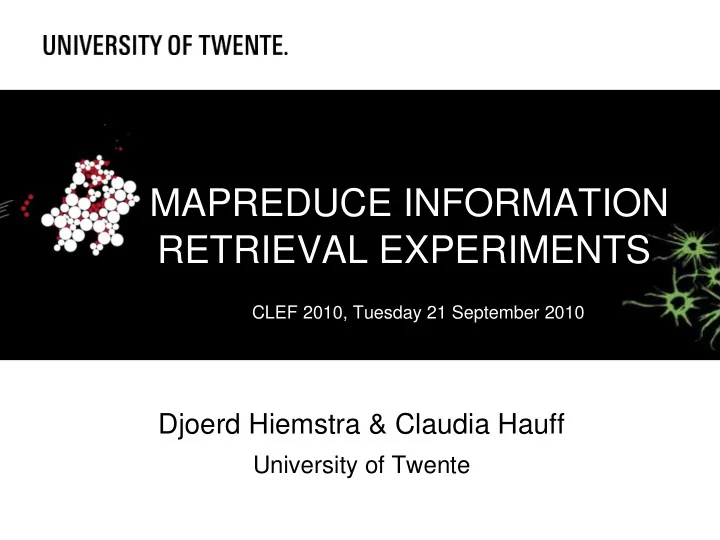

MAPREDUCE INFORMATION RETRIEVAL EXPERIMENTS CLEF 2010, Tuesday 21 September 2010 Djoerd Hiemstra & Claudia Hauff University of Twente
INSPIRED BY GOOGLE... 2
… A NEW COURSE ON “BIG DATA” Distributed Data Processing using MapReduce M.Sc. Course Computer Science with Maarten Fokkinga Nov. 2009 – Feb. 2010 3
FAQ: HOW TO DO CLEF? 1. Have a really cool new idea :-) 2. Code the new approach in PF/Tijah, or :-( Lemur, or Terrier, or Lucene... :-| 3. Index documents from a test collection 4. Put the test queries to the experimental :-| search engine and gather the top X results 5. Compare the top X to a golden standard :-) 6. Done! :-P 4
CODE THE NEW APPROACH? 5
MAP/REDUCE “A simple and powerful interface that enables automatic parallelization and distribution of large-scale computations, combined with an implementation of this interface that achieves high performance on large clusters of commodity PCs.” Dean and Ghermawat, “MapReduce: Simplified Data Processing on Large Clusters”, 2004 6
MAP/REDUCE More simply, MapReduce is: A parallel programming model (and implementation) 7
MAP/REDUCE PROGRAMMING MODEL Process data using map() and reduce() functions The map() function is called on every item in the input and emits intermediate key/value pairs All values associated with a given key are grouped together The reduce() function is called on every unique key, and its value list, and emits output values 8
MAP/REDUCE: PROGRAMMING MODEL More formally, map(k1,v1) --> list(k2,v2) reduce(k2, list(v2)) --> list(v2) 9
MAP/REDUCE: WORD COUNT EXAMPLE mapper (DocId, DocText) = FOREACH Word IN DocText OUTPUT(Word, 1) reducer (Word, Counts) = Sum = 0 FOREACH Count IN Counts Sum = Sum + Count OUTPUT(Word, Count) 10
MAP/REDUCE RUNTIME SYSTEM 1. Partitions input data 2. Schedules execution across a set of machines 3. Handles machine failure 4. Manages interprocess communication 11
MAP/REDUCE: ANCHOR TEXTS mapper (DocId, DocText) = FOREACH (AnchorText, Url) IN DocText OUTPUT(Url, AnchorText) reducer (Url, AnchorTexts) = OutText = '' FOREACH AnchorText IN AnchorTexts OutText = OutText + AnchorText OUTPUT(Url, OutText) 12
MAP/REDUCE: SEQUENTIAL IR mapper (DocId, DocText) = FOREACH (QueryID, QueryText) IN Queries Score = cool_score(QueryText, DocText) IF (Score > 0) THEN OUTPUT(QueryId, (DocId, Score)) reducer (QueryId, DocIdScorePairs) = RankedList = ARRAY[1000] FOREACH (DocId, Score) IN DocIdScorePairs IF (NOT filled(RankedList) OR Score > smallest score(RankedList)) THEN ranked_ins(RankedList, (DocId, Score)) FOREACH (DocId, Score) IN RankedList OUTPUT(QueryId, DocId, Score) 13
“LET’S QUICKLY TEST THIS ON 12 TB OF DATA”
CASE STUDY: CLUEWEB09 Web crawl of 1 billion pages (25 TB) crawled in Jan. – Feb. 2009 using only the English pages (0.5 billion) Cluster of 15 commodity machines running Hadoop 0.19.2 15
16
CODE THE NEW APPROACH 17
ANCHOR TEXTS Takes about 11 hours Anchor texts available from: http://mirex.sourceforge.net 18
SEQUENTIAL SEARCH 50 test queries take less than 30 minutes on Anchor Text representation Language model, no smoothing, length prior Expected Precision at 5, 10 and 20 documents (MTC method): 0.42 0.39 0.35 (0.44 0.42 0.38 U. Amsterdam) (0.43 0.38 0.38 Microsoft Asia) (0.42 0.40 0.39 Microsoft UK) 19
EXPERIMENTAL RESULTS 20
BENEFITS FOR RESEARCHERS 1. Spend less time on coding and debugging 2. Easy to include new information that is not in the engine’s standard inverted index 3. Oversee all the code used in the experiment 4. Large-scale experiments done in reasonable time 21
CONCLUSION Less than 10 times slower than “Lemur one node” (on same anchor index) Faster turnaround of the experimental cycle: Faster coding = more experiments = more improvement of search quality = better system! 22
23
ACKNOWLEDGEMENTS Maarten Fokkinga, Sietse ten Hoeve, Guido van der Zanden, and Michael Meijer Yahoo Research, Barcelona Netherlands Organization for Scientific Research (NWO), grant 639.022.809. 24
Recommend
More recommend